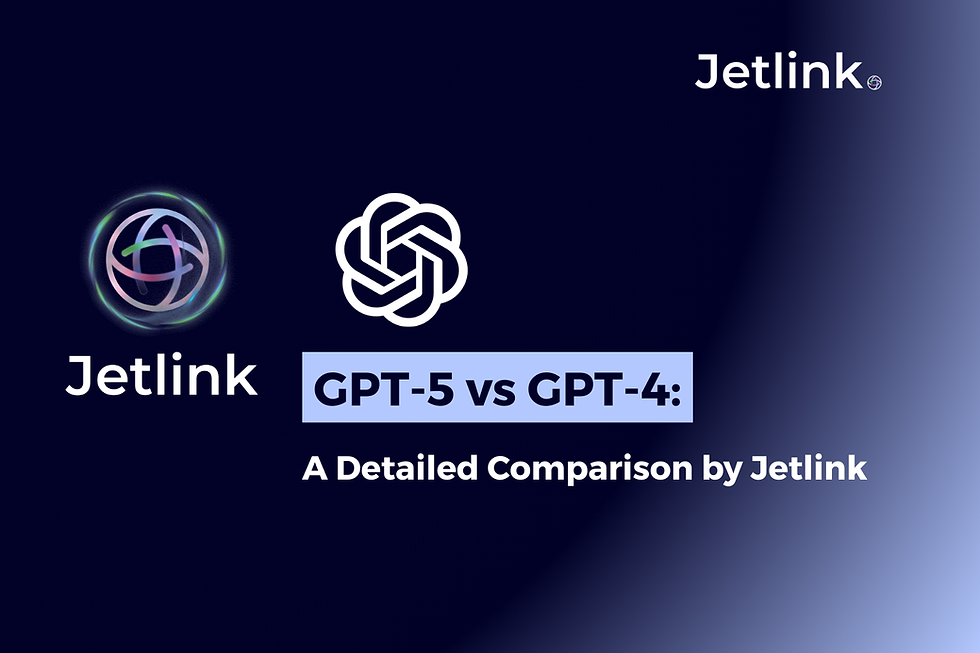From Custom to Standard: How Jetlink’s Cross-Agent Protocol Speaks MCP
- Jetlink
- Sep 8
- 3 min read

Introduction
In the rapidly evolving world of agentic AI, interoperability is no longer a nice-to-have—it’s the key to scaling. Enterprises don’t want siloed assistants; they want a connected ecosystem where agents can seamlessly exchange information, trigger actions, and integrate with external systems.
At Jetlink, we’ve invested heavily in typed interfaces and a cross-agent handoff protocol that make our multi-agent environments robust and efficient. But as the broader ecosystem rallies behind the Model Context Protocol (MCP), a natural question emerges:
How does Jetlink’s custom protocol map to MCP—and why should our customers care?
Why MCP Matters Now
Think of MCP as the USB-C of AI systems. It’s an open standard, backed by players like OpenAI and Google, that defines how agents talk to external tools and data sources. Instead of bespoke connectors for every SaaS platform, MCP promises a uniform handshake: predictable authentication, typed schemas, and consistent logging.
For enterprises, this means:
Faster integrations: “Plug-and-play” connections with the growing MCP server ecosystem.
Governance by design: Built-in scopes, policies, and observability.
Future-proofing: As MCP adoption accelerates, compatibility becomes a competitive advantage.
Mapping Jetlink Concepts to MCP
The good news: Jetlink’s architecture aligns naturally with MCP. Here’s a quick translation table:
Jetlink Concept | MCP Equivalent |
Agent Action / Tool | MCP Tool |
Typed Interfaces | MCP Input/Output Schemas |
Cross-Agent Handoff | MCP Server Discovery |
Orchestrator & Guardrails | MCP Authorization Hooks |
This conceptual overlap means we can “speak MCP” without abandoning the strengths of Jetlink’s protocol.
Three Integration Patterns
1. Proxy (Quick Bridge)
Jetlink agents continue speaking our internal protocol, but a lightweight proxy converts requests into MCP calls.
✅ Speed: Ideal for proofs of concept.
❌ Trade-off: Two layers of configuration, long-term maintenance overhead.
2. Dual-Stack (Phased Transition)
Agents can call both Jetlink and MCP tools. You start by routing 10% of traffic to MCP, validate results, and scale up.
✅ Risk control: Shadow testing and A/B comparisons.
❌ Complexity: Temporarily maintaining both stacks.
3. Native (Full Adoption)
Jetlink actions are defined directly as MCP tool invocations.
✅ Cleanest design: Unified observability and governance.
❌ Investment: Requires upfront schema and policy harmonization.
Example: Order Status Check
Let’s make it concrete. A customer asks, “Where is my order?”
The Jetlink orchestrator triggers the order_status action with orderId.
2. A proxy translates the payload into an MCP tool call: { "order_id": "12345", "locale": "en-US" }
3. The MCP server queries the Order Management System and returns a typed result.
4. Jetlink applies role-based filters (masking sensitive fields) and delivers a user-friendly response.
If the MCP server times out, Jetlink gracefully falls back: “We’re checking your order status right now. It may take a moment. Would you like us to notify you once it’s ready?”
Governance and Observability
Integrating MCP is not just about connectivity—it’s about control. Here are non-negotiables:
Token Scopes: Never grant more authority than necessary.
Audit Logs: Every tool call should have a correlation ID tying it to a user request.
Human-in-the-Loop: For high-risk actions (refunds, cancellations), add approval workflows.
Error Recovery: Define “undo” strategies where possible—rollback actions build trust.
Lessons Learned
Through early pilots, we’ve observed:
Latency is manageable with Streamable HTTP (vs. SSE), especially in voice-driven use cases.
Schemas are gold: Typed I/O reduces runtime errors and debugging overhead.
Customers trust transparency: When agents explain what action they’re taking, adoption rises.
Conclusion
MCP is not here to replace Jetlink’s cross-agent protocol. It’s here to complement it. By mapping our internal strengths—typed interfaces, orchestrated handoffs—onto MCP’s standard, we unlock:
Faster external integrations.
Stronger governance and security.
Future-proof compatibility with the growing MCP ecosystem.
Our recommendation? Start small. Use a proxy for quick wins, move to dual-stack for validation, and evolve into native MCP for strategic use cases.
Jetlink’s vision has always been about connecting intelligent agents to real-world outcomes. With MCP, that vision becomes interoperable at scale.

.png)
.png)



Comments